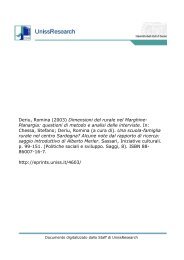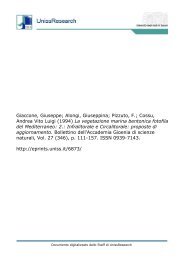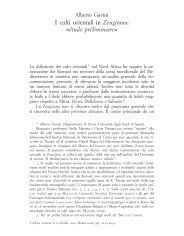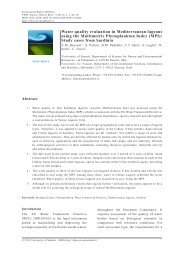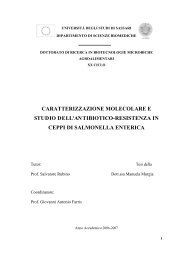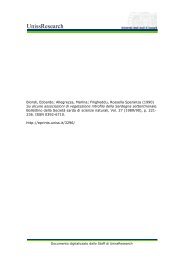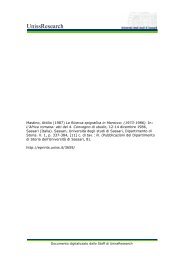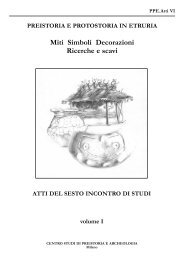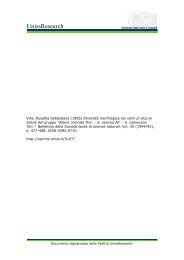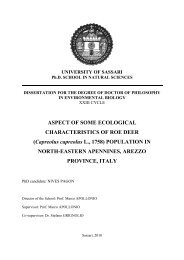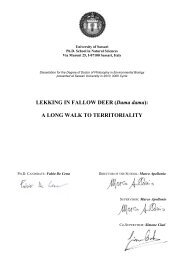Prospecting for safe (low fluoride) - Hydrology and Earth System ...
Prospecting for safe (low fluoride) - Hydrology and Earth System ...
Prospecting for safe (low fluoride) - Hydrology and Earth System ...
You also want an ePaper? Increase the reach of your titles
YUMPU automatically turns print PDFs into web optimized ePapers that Google loves.
1084 G. Ghiglieri et al.: <strong>Prospecting</strong> <strong>for</strong> <strong>safe</strong> groundwater in the Eastern African Rift<br />
with fresh hydrogeological <strong>and</strong> geophysical surveys carried<br />
out in the frame of the present research. The main aquifer<br />
systems consist of volcanic <strong>for</strong>mations, occurring singularly<br />
or superimposed upon one another. Subordinate perched<br />
aquifers (some previously localized) are present in some sedimentary<br />
<strong>for</strong>mations. The thickness of the volcanic rocks is<br />
only approximately known because of uncertainties associated<br />
with the geological <strong>and</strong> geomorphological events which<br />
occurred during the Cenozoic era. However, it is clear that<br />
these events have heavily influenced the geometry of the<br />
aquifers, the recharge <strong>and</strong> discharge areas <strong>and</strong> the groundwater<br />
quality. The scale of the map <strong>and</strong> the amount of available<br />
data, however, prevents a detailed mapping of all these<br />
parameters. From a hydrogeological point of view, the lithostratigraphical<br />
<strong>for</strong>mations can be grouped into two main hydrogeological<br />
units, namely a volcanic <strong>and</strong> a sedimentary<br />
unit (Fig. 2).<br />
2.2.1 Volcanic hydrogeologic unit<br />
This unit is divided into four hydrogeologic complexes:<br />
– Meru west Group (Nvm);<br />
– Lahars of various ages (Nzd1), Ngare Nanyuki lahars<br />
(Nzd2), Momella Lahar (Nzd3);<br />
– Main cone group (Nvm), Ash cone group (Nvn);<br />
– Mantling ash (Nvf);<br />
Meru west Group (Nvm) complex<br />
This <strong>for</strong>mation belongs to the “older extrusive”, <strong>and</strong> is exposed<br />
on the west side of Mt. Meru. The rocks consist predominantly<br />
of nephelinite lavas <strong>and</strong> breccias which contain<br />
dominant phonolite clasts. The aquifer hosted in this <strong>for</strong>mation<br />
has fractured permeability.<br />
Lahars of various age (Nzd1, Nzd2, Nzd3) complex<br />
From a hydrogeological point of view, the lahars can be<br />
grouped within a single complex. Lahars (Nzd1) of considerable<br />
extension are commonly found interbedded with sedimentary<br />
sequences. These lahars are characterized by the<br />
presence of large <strong>and</strong> abundant boulders of feldsparphyric<br />
phonolite, with alkali feldspar phenocrysts occurring within<br />
a fine-grained matrix of variable hardness. Nzd2 <strong>and</strong> Nzd3<br />
are exposed on the north-eastern <strong>and</strong> eastern slopes of the<br />
volcano, the <strong>for</strong>mer near Ngare Nanyuki <strong>and</strong> Uwiro graben,<br />
<strong>and</strong> the latter near the Momella lakes. The aquifers hosted in<br />
these rocks have double permeability, as they are both fractured<br />
<strong>and</strong>, to some extent, porous.<br />
Main cone group (Nvm) complex<br />
The Mt. Meru volcano was active from 0.20 to 0.08 My<br />
BP. Volcanic activity extended the main cone to an alti-<br />
tude of at least 4877 m a.s.l., <strong>and</strong> perhaps was considerably<br />
higher at one time. The Main Cone group (Nvm) <strong>and</strong> Little<br />
Mt. Meru group (Nvp) materials are predominantly volcanic<br />
breccias <strong>and</strong> tuffs of many grain sizes, but phonolitic<br />
<strong>and</strong> nephelinitic (Nv) lavas are sporadically intercalated. The<br />
aquifer hosted in these rocks has double permeability (fractured<br />
<strong>and</strong> porous). The elevation difference between the<br />
recharge <strong>and</strong> discharge areas al<strong>low</strong>s <strong>for</strong> the infiltration of<br />
rain water, particularly where the permeability is high (intensive<br />
fracturing). Along with a considerable number of<br />
high-yielding springs, this structure is responsible <strong>for</strong> the<br />
groundwater having a particularly short residence time. A<br />
further feature of the Main Cone group is the common occurrence<br />
of viscous domes or tholoids (Nvg), usually of<br />
feldsparphyric phonolite composition. These can occur at all<br />
levels, although there is a zone of especially large adventitious<br />
tholoids on the northern flanks (i.e. Mt. Songe). The occurrence<br />
of domes constitutes a lateral hydrogeological impermeable<br />
limit, which limits the circulation of groundwater.<br />
Mantling ash (Nvf) complex<br />
Thick ash, pumice <strong>and</strong> tuff deposits overlie large areas of the<br />
foothills of Mt. Meru, especially on its western slopes. In<br />
the study area, there are outcrops near Oldonyo Sambu <strong>and</strong><br />
Kisimiri (north of Mt. Meru). This <strong>for</strong>mation, due to its finegrained<br />
nature <strong>and</strong> clay alteration, is practically impermeable,<br />
so no springs emerge from it. Sometimes the complex<br />
underlies or surrounds an aquifer.<br />
2.2.2 Sedimentary hydrogeologic unit<br />
This unit is made up of fine-grained alluvial <strong>and</strong> lacustrine<br />
sediments, <strong>and</strong> hence is characterized by a <strong>low</strong> transmissivity.<br />
The occurrence of these sediments generates a swampy<br />
flatl<strong>and</strong> crossed by the Engare Nanyuki River, which terminates<br />
towards the west in an area scattered with alkaline<br />
lakes. A perched, <strong>low</strong> productivity aquifer occurs in this <strong>for</strong>mation<br />
– of the few springs present, most have only a poor<br />
yield.<br />
3 Materials <strong>and</strong> methods<br />
3.1 Hydrogeological surveys<br />
The hydrogeological survey, which was extended beyond the<br />
limits of the two study wards, identified <strong>and</strong> catalogued 52<br />
water points <strong>and</strong> 46 springs (30 in the Ngarenanyuki ward<br />
<strong>and</strong> 16 in Oldonyosambu), <strong>and</strong> included six surface water<br />
samples (rivers <strong>and</strong> lakes). For each water point, the fol<strong>low</strong>ing<br />
parameters were recorded: elevation, geographical coordinates<br />
(GPS), pH, electrical conductivity, temperature, <strong>fluoride</strong><br />
content, yield (estimated values), hydrogeological characteristics<br />
<strong>and</strong> spring classification (Tables 1 <strong>and</strong> 2). Each<br />
water point was identified by an alphanumeric code. The in<br />
Hydrol. <strong>Earth</strong> Syst. Sci., 14, 1081–1091, 2010 www.hydrol-earth-syst-sci.net/14/1081/2010/



